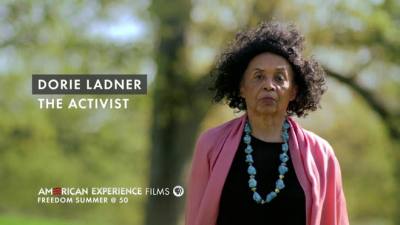
Dorie Ladner was “born a rebel against oppression.” A native of the Hattiesburg, Mississippi community known as Palmer’s Crossing, she spent her childhood fighting back against the oppressive racial norms that governed the lives of Black people there. Her mother taught all of her eight children that they “were as good as anybody.”
Accommodating to white supremacy was not in her makeup. One day when she was twelve, Dorie was reading an issue of Jet Magazine at a convenience store, when the store’s white clerk “slapped [her] on the behind.” “I turned around and started beating him with the bag of doughnuts,” she recalled. When she told her mother of the incident, her mother replied “you should have killed him. Don’t ever let any white man touch you wrong.” So, explained Dorie, when she and her sister Joyce became part of the Movement, they were simply “doing what they prepared us to do.”
The Ladner family was close to Vernon Dahmer and his family. Dahmer was the president of the Forrest County branch of the NAACP and a vocal proponent of voting rights. Dahmer helped the Ladner sisters form an NAACP Youth Council in nearby Hattiesburg. Clyde Kennard, another older activist who attended school at the University of Chicago, agreed to serve as the youth council’s advisor. Pretty soon, Kennard and Dahmer were bringing the Ladner sisters to Jackson for statewide NAACP meetings. “I’m so grateful that I was exposed to people who at the time had vision,” remembered Dorie Ladner.
Both Dahmer and Kennard were killed because of their leadership in civil rights struggle. Both deaths profoundly affected Dorie and her sister.
The Ladners met Medgar Evers on one of their Jackson trips, and he also became an important mentor when they enrolled in Jackson State College. “Every Wednesday, we would go over and talk to him about freedom, which was abstract; all we wanted to know was about our freedom,” Dorie explained. In 1961, with Evers’ guidance, Ladner joined the protests of the “Tougaloo [College] Nine,” a group of students from Tougaloo who were arrested for trying to integrate the public library in downtown Jackson. As a consequence of her activism, Ladner was expelled from Jackson State. She and her sister later matriculated at Tougaloo College, which was known for its liberal stance towards student activism.

Emma Bell, Dorie Ladner, Dona Richards, Sam Shirah, and Doris Derby outside 16th Street Baptist Church funeral, September 1963, Danny Lyon, Memories of the Southern Civil Rights Movement 96-97, dektol.wordpress.com
When Evers was assassinated in June, 1963, it was especially hard on Dorie and her sister. The anger that had been building up after every murder and lynching, especially those of Clyde Kennard and Emmett Till, reached its boiling point the next day. The day after Evers’ murder, Dorie ran up to two white police officers sitting in front of the Jackson’s Black Masonic Temple (which also served as the NAACP’s headquarters) and shouted at them, “Where were you last night? Why are you here now? Shoot! Shoot! Shoot us in the back like you did Medgar Evers.”
Despite her family’s insistence that she get an education, Dorie dropped out of Tougaloo three separate times to work for SNCC full-time. She once told her sister Joyce, “I can’t stay in school and know my people are suffering.” In the summer of 1962, she started working on SNCC’s voter registration projects in the Delta. Three years later, she became SNCC’s project director in Natchez, Mississippi.
Although Ladner was raised never to let fear prevent her from doing what she knew was right, she understood the constant possibility and danger of white violence. Upon entering Natchez with former SNCC chair Chuck McDew and field secretary George Greene, McDew handed her a gun for protection. Despite never needing to use it, Ladner was certain she would’ve if she needed to. She once said, “I didn’t think about the ramifications of anything like that; it was save yourself, survive.”







